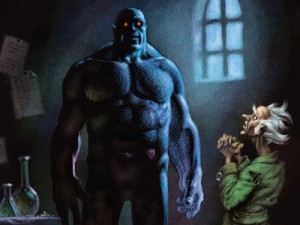Torah Fan Fiction March 15, 2010 – Posted in: Aberrant Normalcy
 In response to the article by Michael Weingrad about “Why There Is No Jewish Narnia,” I have decided to investigate the mythological roots of my religion, and so I picked up Tree Of Souls, The Mythology of Judaism, by Howard Schwartz from the library. It’s a monster tome (pun, intended), clocking in at some six hundred pages. I think it’s thicker than my phone book. I’m barely past the introduction, but I’m already brimming with story ideas, and I’m discovering many things I didn’t know. For example, in orthodox Judaism it’s traditional to mourn the death of a loved one for eleven months. Why not twelve months, a year? Well, it’s because in Jewish myth, the souls of all but the most righteous go to the Hades-like realm of Gehenna. There they are burned of their sins by angels for a year. The eleven months then — not twelve — is to signify that the mourned doesn’t require the full year of sin purification. Their good deeds in life reduce the sentence. It’s a sign of respect.
In response to the article by Michael Weingrad about “Why There Is No Jewish Narnia,” I have decided to investigate the mythological roots of my religion, and so I picked up Tree Of Souls, The Mythology of Judaism, by Howard Schwartz from the library. It’s a monster tome (pun, intended), clocking in at some six hundred pages. I think it’s thicker than my phone book. I’m barely past the introduction, but I’m already brimming with story ideas, and I’m discovering many things I didn’t know. For example, in orthodox Judaism it’s traditional to mourn the death of a loved one for eleven months. Why not twelve months, a year? Well, it’s because in Jewish myth, the souls of all but the most righteous go to the Hades-like realm of Gehenna. There they are burned of their sins by angels for a year. The eleven months then — not twelve — is to signify that the mourned doesn’t require the full year of sin purification. Their good deeds in life reduce the sentence. It’s a sign of respect.
There’s also a large thread of dualism throughout Judaism, which at first blush seems odd for a religion that prides itself on its strict monotheism. The Shekinah, or the Divine Presence, is sometimes referred to as the Sabbath Bride. Supposedly, when the second Temple was destroyed, the Shekinah, the feminine aspect of God, came down to dwell on earth among humanity, separating from God in heaven, to be reunited with God when the Messiah comes. Some sects of Judaism go outside to greet the Sabbath Bride on Friday nights, and they consider it imparting them, for the duration of the sabbath, with a second, holy soul.
There are also virgin births (in one story, God is the father of Isaac, not Abraham), and angels coming down to earth to fornicate with women and create a race of humans known as the Nephilim.
I’m reading this book for many reasons. I’ve found that I have a lot of fun writing stories about desert people, and I think this has a lot to do with my traditional Jewish upbringing, the Passover celebration where one says, “We were slaves in Egypt” and not “They were slaves…,” the many stories of a desert-roaming people, and my overactive imagination. Today I am less inclined to take anything literally in the bible, but the stories to me are still powerful, as all good literature can be. The midrashic interpretation of the Torah, the filling in the blanks between verses seems a whole lot to me like what I do when I’m writing and building a world. Sometimes, by context or intuition, the gaps are automatically filled by my subconscious. It’s almost as if — and I know I might offend the sensitive — the rabbinical scholars were writing Torah fan fiction. They took characters and settings and interpolated how and why they did the things they do, how they came to be.
I hope to write some Judaic fan fiction too. That is, after I navigate my way through this tome, I plan to write some stories using the mythology I uncover. I don’t plan to create a new Narnia. I’m not interested in converting people or convincing them of the uprightness of one faith over another. I just plan to have fun exploring these ancient stories and revealing them in new ways. I hope to write about some of what I find here.
